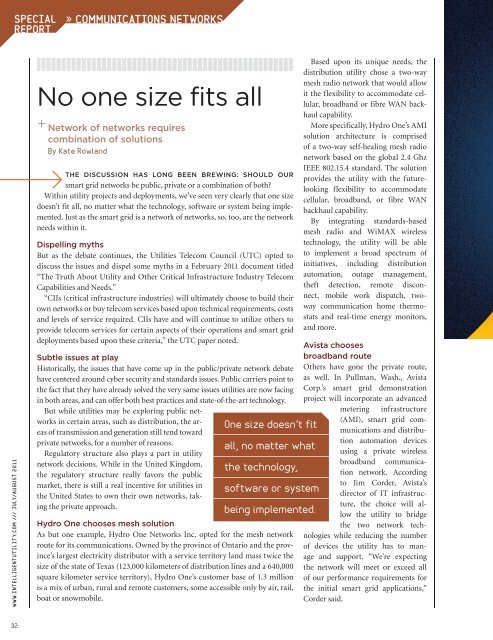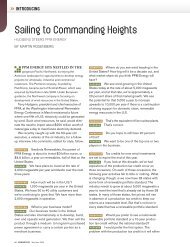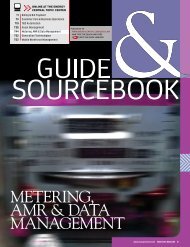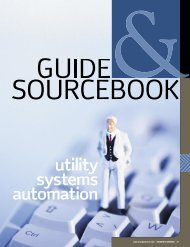FERC vs NERC: A grid control showdown over cyber security
FERC vs NERC: A grid control showdown over cyber security
FERC vs NERC: A grid control showdown over cyber security
Create successful ePaper yourself
Turn your PDF publications into a flip-book with our unique Google optimized e-Paper software.
WWW.INTELLIGENTUTILITY.COM /// JULY/AUGUST 2011<br />
32<br />
» COMMUNICATIONS NETWORKS<br />
No one size fits all<br />
+ + Network of networks requires<br />
combination of solutions<br />
By Kate Rowland<br />
THE DISCUSSION HAS LONG BEEN BREWING: SHOULD OUR<br />
smart <strong>grid</strong> networks be public, private or a combination of both?<br />
Within utility projects and deployments, we’ve seen very clearly that one size<br />
doesn’t fit all, no matter what the technology, software or system being implemented.<br />
Just as the smart <strong>grid</strong> is a network of networks, so, too, are the network<br />
needs within it.<br />
Dispelling myths<br />
But as the debate continues, the Utilities Telecom Council (UTC) opted to<br />
discuss the issues and dispel some myths in a February 2011 document titled<br />
“The Truth About Utility and Other Critical Infrastructure Industry Telecom<br />
Capabilities and Needs.”<br />
“CIIs (critical infrastructure industries) will ultimately choose to build their<br />
own networks or buy telecom services based upon technical requirements, costs<br />
and levels of service required. CIIs have and will continue to utilize others to<br />
provide telecom services for certain aspects of their operations and smart <strong>grid</strong><br />
deployments based upon these criteria,” the UTC paper noted.<br />
Subtle issues at play<br />
Historically, the issues that have come up in the public/private network debate<br />
have centered around <strong>cyber</strong> <strong>security</strong> and standards issues. Public carriers point to<br />
the fact that they have already solved the very same issues utilities are now facing<br />
in both areas, and can offer both best practices and state-of-the-art technology.<br />
But while utilities may be exploring public networks<br />
in certain areas, such as distribution, the ar-<br />
One size doesn’t fit<br />
eas of transmission and generation still tend toward<br />
private networks, for a number of reasons.<br />
all, no matter what<br />
Regulatory structure also plays a part in utility<br />
network decisions. While in the United Kingdom,<br />
the technology,<br />
the regulatory structure really favors the public<br />
market, there is still a real incentive for utilities in<br />
software or system<br />
the United States to own their own networks, taking<br />
the private approach.<br />
being implemented.<br />
Hydro One chooses mesh solution<br />
As but one example, Hydro One Networks Inc. opted for the mesh network<br />
route for its communications. Owned by the province of Ontario and the province’s<br />
largest electricity distributor with a service territory land mass twice the<br />
size of the state of Texas (123,000 kilometers of distribution lines and a 640,000<br />
square kilometer service territory), Hydro One’s customer base of 1.3 million<br />
is a mix of urban, rural and remote customers, some accessible only by air, rail,<br />
boat or snowmobile.<br />
Based upon its unique needs, the<br />
distribution utility chose a two-way<br />
mesh radio network that would allow<br />
it the flexibility to accommodate cellular,<br />
broadband or fibre WAN backhaul<br />
capability.<br />
More specifically, Hydro One’s AMI<br />
solution architecture is comprised<br />
of a two-way self-healing mesh radio<br />
network based on the global 2.4 Ghz<br />
IEEE 802.15.4 standard. The solution<br />
provides the utility with the futurelooking<br />
flexibility to accommodate<br />
cellular, broadband, or fibre WAN<br />
backhaul capability.<br />
By integrating standards-based<br />
mesh radio and WiMAX wireless<br />
technology, the utility will be able<br />
to implement a broad spectrum of<br />
initiatives, including distribution<br />
automation, outage management,<br />
theft detection, remote disconnect,<br />
mobile work dispatch, twoway<br />
communication home thermostats<br />
and real-time energy monitors,<br />
and more.<br />
Avista chooses<br />
broadband route<br />
Others have gone the private route,<br />
as well. In Pullman, Wash., Avista<br />
Corp.’s smart <strong>grid</strong> demonstration<br />
project will incorporate an advanced<br />
metering infrastructure<br />
(AMI), smart <strong>grid</strong> communications<br />
and distribution<br />
automation devices<br />
using a private wireless<br />
broadband communication<br />
network. According<br />
to Jim Corder, Avista’s<br />
director of IT infrastructure,<br />
the choice will allow<br />
the utility to bridge<br />
the two network technologies<br />
while reducing the number<br />
of devices the utility has to manage<br />
and support. “We’re expecting<br />
the network will meet or exceed all<br />
of our performance requirements for<br />
the initial smart <strong>grid</strong> applications,”<br />
Corder said.















![View From the Trenches [PDF]](https://img.yumpu.com/18854438/1/190x252/view-from-the-trenches-pdf.jpg?quality=85)
